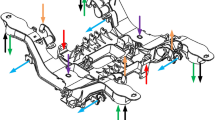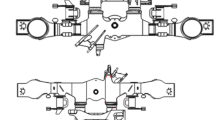Abstract
One of the major problems in structural fatigue life analysis is establishing structural load spectra under actual operating conditions. This study conducts theoretical research and experimental validation of quasi-static load spectra on bogie frame structures of high-speed trains. The quasistatic load series that corresponds to quasi-static deformation modes are identified according to the structural form and bearing conditions of high-speed train bogie frames. Moreover, a force-measuring frame is designed and manufactured based on the quasi-static load series. The load decoupling model of the quasi-static load series is then established via calibration tests. Quasi-static load-time histories, together with online tests and decoupling analysis, are obtained for the intermediate range of the Beijing—Shanghai dedicated passenger line. The damage consistency calibration of the quasi-static discrete load spectra is performed according to a damage consistency criterion and a genetic algorithm. The calibrated damage that corresponds with the quasi-static discrete load spectra satisfies the safety requirements of bogie frames.
Similar content being viewed by others
References
Gassner, E.: Festigkeitsversuche mit wiederholter Beanspruchung im Flugzeugbau (Strength tests under repeated loading for aeronotical engineering). Luftwissen 6, 61–64 (1939)
Schütz, D., Gerharz, J.J.: ENSTAFF—A standard test sequence for composite components combining load and environment. In: Simpson DL, editor. New materials and fatigue resistant aircraft design. 14th International Conference on Aeronautical Fatigue (ICAF), Ottawa, Ont, 425–444 (1987)
Schütz, W.: Standardized stress-time histories—An overview, development of fatigue loading spectra. ASTMSTP 1006, Potter J.M. and Watanable, R.T., American Society for Testing and Materials, Philadelphia, 3–16 (1989)
Ten Have, A.A.: European approaches in standard spectrum development of fatigue loading spectra, ASTM STP 1006, Potter J.M., and Watanable, R.T., American Society for Testing and Materials, Philadelphia, 17–35 (1989)
Breitkopf, G.E.: Basic approach in the development of TURBISTAN, a loading standard for fighter aircraft engine disks. Development of Fatigue Loading Spectra, ASTM STP 1006, Potter J. M. and Watanable, R. T., American Society for Testing and Materials, Philadelphia, 65–78 (1989)
Schijve, J.: Fatigue of structures and materials in the 20th century and the state of the art. International Journal of Fatigue 25, 679–702 (2003)
Heuler, P., Klätschke, H.: Generation and use of standardized load spectra and load-time histories. International Journal of Fatigue 27, 974–990 (2005)
Sonsino, C.M.: Fatigue testing under variable amplitude loading. International Journal of Fatigue 29, 1080–1089 (2007)
Xiong, J.J., Shenoi, R.A.: A load history generation approach for full-scale accelerated fatigue tests. Engineering Fracture Mechanics 75, 3226–3243 (2008)
Tucker, L.E.E., Bussa, S.: The SAE cumulative fatigue damage test program. In: Wetzel RM, ed. Fatigue under Complex Loading-analyses and Experiments. SAE AE-6, 1–54 (1977)
Fash, J.W., Conle, F.A., Minter, G.L.: Analysis of irregular loading histories for the SAE biaxial fatigue program. In: Leese GL, Socie D, eds. Multiaxial Fatigue: Analyses and Experiments. SAE AE-14, 33–59 (1989)
Berger, C., Eulitz, K.G., Heuler, P., et al.: Betriebsfestigkeit in Germany—An overview. International Journal of Fatigue 24, 603–625 (2004)
Oelmanm, B.: Determination of load spectra for durability approval of car drive lines. Fatigue & Fracture of Engineering Materials & Structures 25, 1121–1125 (2002)
Sonsino, C.M., Klätschke, H., Schütz, W., et al.: Standardised load sequence for offshore structures-wave action standard history—WASH I. Fraunhofer-Institut für Betriebsfestigkeit (LBF), Industrieanlagen-Betriebsgesellschaft mbH (IABG). LBF-Report No. FB-181 (1988) IABG-Report No. TF-2347 (1988)
Schütz, W., Klätschke, H., Hück, M., et al.: Standardised load sequence for offshore structures—WASH I. Fracture of Engineering Materials & Structures 13, 15–29 (1990)
Li, S.S., Cui, W.C.: On generation of standardized load-time histories and standardized load spectra. Journal of Ship Mechanics 15, 1405–1415 (1011)
Brune, M., Zenner, H.: Verbesserung der Lebensdauerabsch ätzung für Bauteile in Walzwerksantrieben (Improvement of life prediction for components of steel mill drives). VBFEh Düsseldorf, Germany, Report ABF40.1 (1990)
Ten Have, A.A.: WISPER and WISPERX-final definition of two standardized fatigue loading sequences for wind turbine blades. NLR Report CR 91476 L, Amsterdam (1991)
Epaarachchi, J.A., Clausen P.D.: The development of a fatigue loading spectrum for small wind turbine blades. Journal of Wind Engineering and Industrial Aerodynamics 94, 207–223 (2006)
Schupp G., Jaschinski, A.: Virtual prototypeing: the future way of designing railway vehicles. International Journal of Vehicle Design 22, 93–115 (1999)
Andersson, C., Abrahamsson, T.: Simulation of interaction between a train in general motion and a track. Vehicle System Dynamics 38, 433–455 (2002)
Ma, W.H., Luo, S.H.: Song, R.R.: Load spectrum research of tumbler journal box node of high-speed motor car. Railway Locomotive & Car 29, 12–14, 50 (2009)
Ren, Z.S., Sun, S.G., Li, Q.: Axle spring load test and dynamic characteristics analysis of high speed EMU. Journal of Mechanical Engineering 46, 109–115 (2010)
Zhang, S.G.: Study on testing and establishment method for the load spectrum of bogie frame for high-speed trains. Science China Series E: Technological Sciences 51, 2142–2151 (2008)
The static strength and fatigue strength calculate report for motor car bogie frame for CRH3 EMU. Beijing Jiaotong University, Beijing (2009)
Railway applications—Methods of specifying structural requirements of bogie frames. British Standard BS EN 13749, United Kingdom (2005)
Motive power units-Bogies and running gear-Bogie frame structure strength tests. International Union of Railways UIC Code615-4 (1994)
Test methods of static load for truck frames and truck bolsters of railway rolling stock. Japanese Industrial Standard (JIS) E 4208(1988)
Yan, J.M.: Vehicle Engineering, (2nd edn.) China Railway Publishing House, Beijing (2004)
Liu, Z.M.: Research on fatigue life and reliability of welding frame under random loads, [Ph.D. Thesis]. Beijing Jiaotong University, Beijing (2001)
Glinka, G., Kam, J.C.P.: Rainflow counting algorithm for very long stress histories. International Journal of Fatigue 9, 223–228 (1987)
Schijve. J.: Fatigue of Structures and Materials, (2nd edn.) Springer Science+Business Media, B. V., Berlin. 259–292 (2009)
Miner, M.A.: Cumulative damage in fatigue. Journal of Applied Mechanics-Transactions of the ASME 12, 159–164 (1945)
Fatigue design and assessment of steel structures. British Standand BS 7608 (1993)
Kassner, M.: Fatigue strength analysis of a welded railway vehicle structure by different methods. International Journal of Fatigue 34, 103–111 (2012)
David, E., Goldberg.: Genetic Algorithms in Search, Optimization and Machine Learning. Addison-Wesley Longman Publishing Co., Boston (1989)
User’s Guide: Genetic altorithm and direct search toolbox for use with MATLAB. The MathWorks (2004)
Author information
Authors and Affiliations
Corresponding author
Additional information
The project was supported by the National Natural Science Foundation of China (U1134201), and partly supported by the National High Technology Research and Development Program of China (0912JJ0104-DL00-H-HZ-001-20100105).
Rights and permissions
About this article
Cite this article
Zhu, N., Sun, SG., Li, Q. et al. Theoretical research and experimental validation of quasi-static load spectra on bogie frame structures of high-speed trains. Acta Mech Sin 30, 901–909 (2014). https://doi.org/10.1007/s10409-014-0117-7
Received:
Revised:
Accepted:
Published:
Issue Date:
DOI: https://doi.org/10.1007/s10409-014-0117-7




